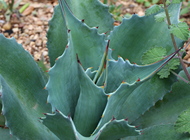 |
Thalictrum — meadow rue |
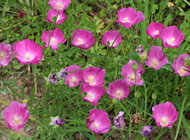 |
A penchant for meadow rues
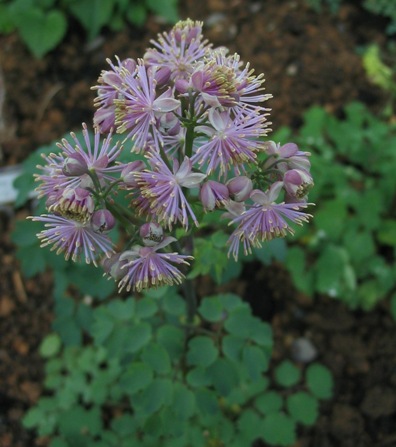
Just about all gardeners have a hobby plant type or two - a genus or
family they particularly like, for which they seek out as many varieties as
they can get their hands on. In serious cases, this turns into plant
collectorship and the obsessive compulsive tendencies that go along with that.
I'm not sure I qualify for the worst category, but as hobby genuses go,
thalictrum is certainly one of mine. I've tried to grow many, and have
succeeded at a few. This page showcases the varieties that grow in our garden,
and tells a little about my experiences with growing meadow rues.
I'm starting this page as November draws to a close, so I've no
opportunity to run out and check appearances, or take a few extra photos -
all that will have to wait till next year. For now, I'll draw on photos
already in my collection, and my (not-so-photographic) memory.
The genus
Thalictrum is a genus of about two hundred herbaceous perennial species,
widely distributed around the world (North and South America, Europe,
central and east Asia, and Africa). They belong to the large buttercup
family (ranunculaceae), also home
to other garden staples such as clematis, columbines, anemones, delphiniums,
and hellebores. Botanists distinguish them from other closely related
genuses by their flower characteristics: the lack of nectar and petals, the
way they bear seeds in achenes. They also note that
some species are dioecious (male and female reproductive organs on separate
plants), while others are hermaphrodite (boy and girl parts on the same
plant). The latter tend to have the showier flowers.
Cultivation
I can't speak from a position of authority here - just report my own
experience. In general, I consider thalictrum to be somewhat finnicky
plants, worthy of good garden conditions - until they prove otherwise. By
"good garden conditions", I mean soil with some good organic content, a
position that's within reach of the sprinklers that I put to use when
drought strikes, and some afternoon shade.
In our first attempt at growing meadow rue, we planted Thalictrum
aquilegiifolium in a full-sun area that had otherwise good garden conditions.
It lasted a year. In subsequent attempts, we've been sure to provide a bit of
shelter from afternoon sun. On the other hand, the taller species in our
garden (T. flavum glaucum, T. pubescens) get full sun, and are
perfectly happy. In fact, these have a tendency to reach and flop when they get
more than a touch of shade, so full sun is best. Similarly, T. rochebrunianum
thrives in full sun, and I suspect many of the tiny alpines do as well.
The water requirement is probably less flexible - but since I've not dared
plant them in areas that get very dry, I've no proof of this.
Propagation
Nearly all of my experience propagating meadow rues is by seed - most species
grow upright from a small base, that doesn't appear to lend itself to division.
An exception is T. flavum glaucum, which forms robust clumps that can
be divided every few years. But let's focus on seed.
Germination results from my various attempts are detailed on the individual
plant portraits. My experience of course reflects the species native to
temperature climates. For these, generally, germination appears to require, or at least benefit
from, a cold moist stratification period. In some cases, an initial warm
conditioning stage may also be helpful. A few species sprout easily when
sown at room temperature.
Only two thalictrum species have self-seeded in our garden: T.
pubescens (abundantly), and T. rochebrunianum (sparingly). As you
might imagine, collecting seed from these is easy. Although not a
self-seeder for us, T. aquilegiifolium also sets plenty of viable
seed. Others are much less generous with their seed production: T. flavum
glaucum produces few viable seeds among many duds, while T.
delavayi flowers less abundantly, and makes just a small number of
viable seeds any year.
Leaf shapes and growth habit
The signature garden species is certainly Thalictrum aquilegiifolium.
Meadow rues are not often offered for sale around here, but when they are, it's
usually this species, whose name translates to "columbine-leaved". And sure
enough, the blue-green, compound leaves resemble those of columbines, their
relatives in the buttercup family, to the point where one might confuse one
for the other before the flower stalk goes up. Several other species of
thalictrum share this leaf shape, but others are much more finely cut, and
some, like T. lucidum, are altogether different in appearance.
Meadow rues come in a wide range of sizes, from diminutive alpines species
to towering herbs. They also vary in their habit - some are strictly upright,
producing a single stalk that shoots up to produce the flowers; others produce
multiple flowering stems, often with a more lax habit. This means that meadow
rues can fill a variety of roles in the garden, finding niches in rock gardens
sunny and shady perennial borders, and wilder gardens like cottage gardens and
wildflower meadows.
Flowers
The color of thalictrum flower clusters (which may be determined as much
by the stamens as by the sepals, which are missing or drop quickly in many
species), ranges from white to yellow to lavender-blue in our garden. In many
cases, individual flowers are only apparent close-up: from typical viewing
distance, the effect is produced by the cluster as a whole. Where flowers are
so separate that they make an individual impression, they usually face downward,
weighed down by the heavy reproductive parts. Flowers appear in mid-late spring.
The midsized blues
This group of meadow rues includes the family sedans of the genus –
the most common and steady performers. Besides the T. aquilegiifolium
mentioned previously, I include T. rochebrunianum and T. delavayi in this
clan. Although they share similar flower color in lavender spectrum and a
medium height (2-4 ft), there's enough to distinguish them from each other.
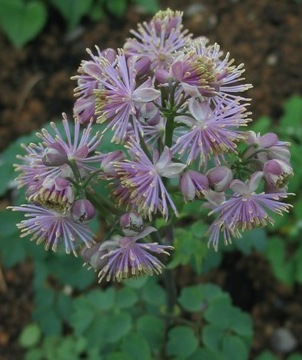
Just peachy for the semi-shaded border, T.
aquilegiifolium grows two to three foot tall. Its overall habit is
upright, but there are multiple leafy stems so that the overall impression
is more mound-like than stalky. The leaves of course resemble those of
columbines in color and general shape, although nobody would confuse the
mature plant, even out of flower, for a columbine. The flowers are often
described as pink or rose, but to my colorblind eye, there's more of a blue
contribution than you'd guess from those descriptions.
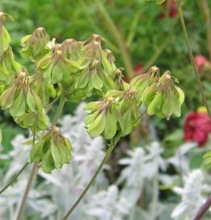
Unique among the meadow rues in our garden is the seed shape produced by
columbine meadow rue. While all thalictrum seed is encapsulated in a husk, this
species has little sails around the seed, giving the seed clusters a cool
appearance.
|
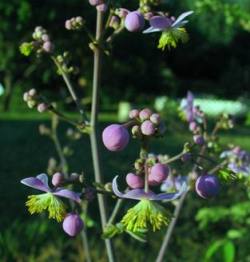
Another popular species is lavender mist meadow rue, T. rochebrunianum.
This is a much more strongly upright plant, with just one or a few flowering
stalks extending about four feet up from a low-growing rosette. The stalks
have an attractive purple cast. Although from a distance the
flowering plant looks like a haze of purple, when you step closer it's
much easier to see the individual flowers, much less densely spaced. Although
it produces seed just as abundantly as columbine meadow rue, the seeds are in
smaller husks, not so obvious when the plants are done blooming.
|
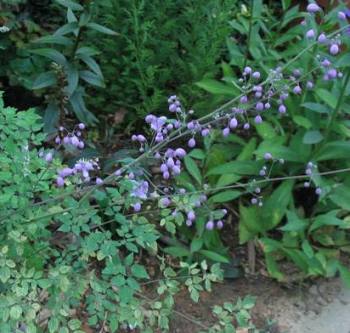
The least common among my blue species is Yunnan meadow rue, T. delavayi.
In many respects, it is similar to lavender mist, but it is more delicate: the
leaves are more finely cut, the flowers more delicately spaced along the stalks.
And the stalks themselves are laxer, with tendency to arch that is charming as
long as it doesn't turn into a flop. They make less of a statement in the
garden, but they're just right in a genteel ensemble of prima donna perennials.
Much as I love this plant, I've not been able to propagate it effectively - the
small number of flowers produce even fewer seeds. I've never noticed any
self-seeding, and my attempts to grow from seed have been unsuccessful more
often than not. So it's a good thing that my original plant has survived all
this time!
|
Yellow puffballs
Continuing for the moment the classification by flower color, let's turn
to the yellow ones. There are two of those in our garden, rather different in
overall appearance.
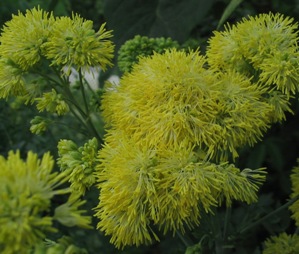
Let's start with yellow meadow rue, T. flavum ssp. glaucum.
From the photo you can see that the origin of the yellow color is not the
presence of yellow sepals or petals, but rather the absence of such structures,
and the abundance of fluffy yellow anthers, all clustered together in dense
flowerheads.
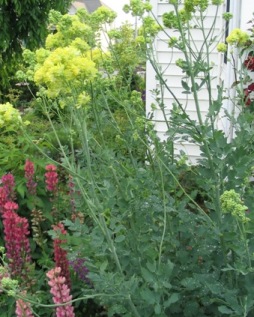
Leaves are produced a good ways up the stems, which
can reach as high as 6 foot - so the whole plant takes some space. Some
gardeners complain that the plants are prone to flop. Indeed, the ones we
once grew in a part of the garden that receives afternoon shade did get
topheavy and leaned over, although they never quite flopped all the way. So
we relocated those - but the other cluster, which receives full sun, has
never had any problem. They are in our back yard island, which has decent
but not great soil, and gets supplemental water in drought but is not the
first in line for water services. Conclusion: give these sun but not too
much TLC, and they'll reward you with sturdy upright growth.
As the subspecies name suggests, the leaves are bluish green. They again
resemble columbine leaves, and are soft and without sheen.
|
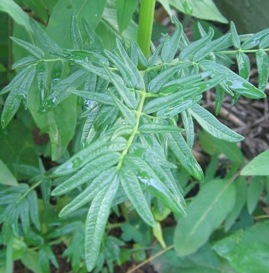
That's where shining meadow rue, T. lucidum,
really takes a departure from the rest of the bunch. The leaves are dark green,
glossy, and narrow, no longer resembling columbine in any way. Quite attractive,
and the plants appear to be strong and hardy. Flowers are much like those of
T. flavum, perhaps in somewhat denser, well-defined puffs.
|
Tall white guys
Departing from the lavenders and yellows, we arrive in white territory.
The species in our garden that fit here are less showy, probably better placed
in a meadow or woodland garden. Since we have neither, they share space with
the rest of the perennials on our plot.
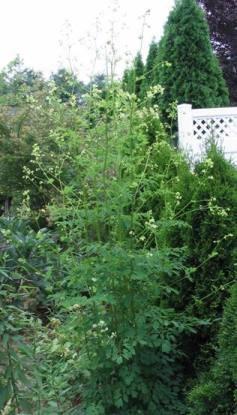
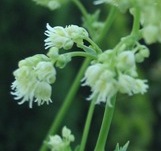
The first one of this description I got my hands on was tall meadow rue,
T. pubescens (a.k.a. T. polygamum),
obtained at a local native plant sale. Indeed this is a tall species,
growing at least six foot tall and strongly upright. Multiple stems rise up
from the basal mound, and weave an airy see-through pattern (which makes it
hard to do them justice in photographs). White flowers appear in clusters in
early summer, adding to the effect, even though individually they're not
much to look at (our original and largest plant is female, which produces
the less showy flowers). Dainty as it may look, this species is not shy
about seeding itself around. The seedlings are only a nuisance in my
off-years, where that part of the garden receives less attention than it
needs. I'm not sure how that comes to be, because this is one of the
dioecious species, which requires male and female plants to reproduce - and
we started with just one plant. Perhaps a botanist can set me straight on
that.
|
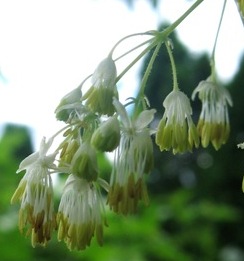
A second larger white one is purple meadow rue, T. dasycarpum. I grew this one from seed, and it hasn't been in the
garden long enough for me to know its ultimate habit, but so far it looks
like it will be shorter than pubescens. The genus name comes from the
pronounced purple coloration of the stems; I must admit I haven't noticed
this on our plants, so I can't be sure of their identity - next year should
bring more opportunities to observe. What is clear is that this plant is
different from others in our garden - the male flowers keep some of their
white sepals, to surround the stamens, whose white filaments and yellow
anthers make for an interesting bicolor when you look up close. The species
name, meaning "hairy-carpelled", refers to the seed structure. I should
check that, too.
One that we tried more recently is western meadow rue, T. occidentale. Supposed to grow 3-4 ft tall, but our
second-year plants didn't reach half that height. So far I'd call the flower
color not so much pinkish white (as other descriptions say) as greenish white -
but I've probably only seen female flowers so far. I hope to have a better
update next year.
|
Itsy-bitsy ones
Let's switch gears and take a look at a few that you have to kneel down
to see properly. My experience with these types is limited, but here goes.
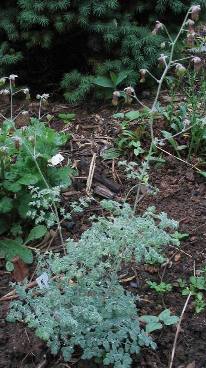
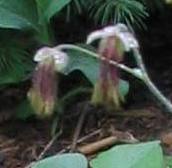
Our first little one came from seed for T. minus. The seedlings grew very slowly, eventually reaching the size
shown in the photo at left. The leaves are tiny and ferny, in a shade of
grayish-green. I used to think I'd missed the flowers year after year, but
upon reinspection of my photos, I think it's more likely that the flowers
just weren't as showy as I expected; the fuzzy enlargement at right shows
typical thalictrum flower structures, with the bicolor filaments and
anthers.
Another tiny one goes by the name 'Afghanistan'. I bought a plant once
(which didn't survive), and also grew a crop from traded seed. Internet research
places this cultivar either in T. minus adiantifolium or in T. isopyroides.
In any case, in habit they are quite similar to my original T. minus. I hope to
have a photo next year.
Finally, we grew alpine meadow rue, T. alpinum,
from seed a couple years ago. These are a bit larger than the two above - so
that the cute tiny-dissected leaflets, while almost as dainty in close-up
inspection, is more evident from typical viewing distance. The flowers, on the
other hand, are almost completely nondescript, as far as I can tell.
|
Other species
Even if I ignore the species from warmer climes (whose attraction is great
but futile), there are many left to explore in our garden. Among the more
gardenworthy ones are T. uchiyamai, T. orientale, and T. diffusiflorum. This
genus can keep me occupied for quite a few more years – which is fine
by me.
Further reading
For botanical information and a collection of photos, visit The Thalictrum
Website of the Oregon State University Herbarium.
List of species in our garden.
Visitors to this page have left the following comments| Linda | Dec 17, 2006 | Thank you for sharing your pics of Thalictrum, I didn't realize there were so many different kinds. I only have two, T. dipterocarpum and T. aquilegilfolium. I love the foliage and the airy flowers. I kept a few stocks with the seeds for dry flower arranging but think I will see if I can get some plants started with them. |
| Will Woodruff | May 13, 2008 | Excellent web page! I have a number of varieties in my garden (delvayi, rochbrunianum,aquilegifolium, minus, flavum glaucum, etc.) growing in two locations. This past winter voles devastated portions, devouring the flavun glaucum in both locations, leaving the other varieties untouched. Do you know why? I can only presume that this variety, whose blooms are so fragrant, must have roots that also have roots whose flavor attracts the voles.
I've no idea - the T. flavum glaucum is such a large, robust plant that it's hard to imagine how voles would destroy it completely. We do have voles, but they don't seem to wreak too much havoc. |
| Phyllis Halloran | Jun 13, 2008 | Hi, I love your pictures and discriptions. I have columbine meadowrue. It is planted in my perennial garden, toward the back. It is beautiful. This spot has sun most of the day. I purchased lavender mist meadow rue this year. They are beautiful plants also. Do you think it will grow well with all this sun? Thank you in advance for your help.--Phyllis
How well they'll do in full sun depends on your climate. If you have hot summers with dry periods, I think they'll do much better in part shade. But some of my lavender mist are in full sun, and loving it. |
| Mary Ellen | Sep 06, 2008 | Thanks for the information. I enjoyed the website. I have been growing T. Aquilegifolium in a fairly shaded spot for a number of years and it comes back and flowers each year. I recently added 2 more. I just ordered T. delavayi which I will plant in a sunnier but still part shade border. I am lookining forward to watching that one grow. I had hoped to buy T. delavayi 'Album' but couldn't find a supplier. |
| Lee Recca | Mar 15, 2009 | Thank you for this edifying page. I planted a number of seeds native to the foothills of Golden, Colorado, this spring and the thalictrum alpinus was the first to germinate. I love its delicate columbine-like leaves. I have also seen the caterpillars of monarch butterflies feasting on it, so they must love it too! |
| Betsy | Mar 20, 2009 | What is the scientific name for "sparkle meadow rue"? It is availabe in the Michigan Bulb catalog but with no scientific name...thanks!
Yeah, they like to make up their own names. It looks like T. rochebrunianum to me (actually, it does say that, scrolling a bit down their product page). |
| Jules | Jul 14, 2009 | I love thalictrum dioicum (early meadow rue). It grows wild on our wooded lake property in N.W. Wisconsin. Not much root system, but transplants easily. It thrives in partial/full shade and I have found it to be very drought tolerant once established. Also self seeds in my pine needle mulch. I grow it for the lovely foliage that stays green & lacy all summer, and a beautiful golden bronze in fall. |
| Carol | May 21, 2010 | Thank you for an informative and attractive web page....I only have one meadow rue, T. delavayi, but it's one of my favorite plants. I have it planted up against our southern exposed house, under an overhang, no less, and it does fine. It's the same size every year, doesn't require much attention, and produces the daintiest little blossoms. It's been growing in this same Seattle location for over ten years now, right next to my other favorite garden plant, daphne odora. |
| Marlettes | May 28, 2010 | Really enjoyed reading your Thalictrum descriptions and pictures!! Well done.
My Thalictrum rochebrunianum reseeds very nicely for me. I just sprinkle the seed heads around where I want it in the fall. Seeds apprear to like the cold of the winter. Zone 8A/B, Oregon.
I was also able to find the botanical name for the yellow Thalictrum...thanks!!
Warm hugs |
| Julie | May 29, 2010 | Very nice descriptions and pictures! I have Thalictrum dasycarpum in my native garden, and I can tell you from experience that some plants, but not all individual shoots, do turn a very definite purple color in the stems. It's a very striking and unique feature. Hopefully yours turn out to in fact be T. dasycarpum! |
| Aurelia Smith | Mar 11, 2011 | Beautiful! You are lucky you can grow these. You haven't seen heat and drought until you try to garden in the Deep South in a western exposure. Eight whole months of "grrr", and daffodils withering in a week. |
| Jennette | Apr 08, 2011 | Hi Rob. I live right around the corner from you. I hope you will have your plant sale this year. I have had Thalictrum rochebrunianum for a few years now and I'm still not sure I care for it much. I suppose I haven't found the right place in my beds for it. Last year both plants flopped over and my husband asked me "what kind of plant is that?" I will try your suggestion and move it to an all-sun location. |
| Betsy | Apr 11, 2011 | I bought the Sparkle Meadow Rue from Michigan Bulb 3 years ago and it is a delightful plant! They shipped really nice, 4" tall plants....only 3 have made an appearance this spring but we had a really brutal winter here in IL this year (MB will replace plants indefinitely which is nice). I have them in almost full shade and now realize I may need to move them to a partly sunny location. I would highly recommend this plant if you live in a climate where it isn't TOO hot and dry. |
| Valerie perry | Apr 13, 2011 | I am looking for a source for a meadow rue called pink splendide. Do you know of it? I live in canada and am looking for someone who could ship it. Thank you very much.
I've not heard of that one, but it sounds splendid ;-) |
| Betty Jablonski | May 09, 2011 | I've inherited a Meadow Rue and have never had one before. They said it grows 6' and that's all the information I have. The leaves coming out right now resemble Columbine. Your webpage is gorgeous and full of information, however, I'm not sure of the variety I have so can't give more info than that. We live in Canada on Vancouver Island and usually have dry warm summers. I'm just not sure where to plant. We have lots of shade as we're surrounded by large trees and sunny spots here and there throughout the day. The spot where we have most sun would be rather dry. I just don't want to kill it - any suggestions?
The different species have different moisture and sun requirements - so without more information, it's hard to give good advice. The tall ones that I've grown have been fairly drought-tolerant, so I think it's probably safe to plant them in one of the sunnier areas, but keeping it well watered until it is firmly established. |
| Ruthie | May 10, 2011 | Thank you for your web page and information. Also the comments from everyone is so nice and helpful. Betsy I just purchased Sparkle meadow rue also from MB and I was trying to figure out where to but them your comment helped me. Thanks and happy gardening everyone. |
| Linda | May 17, 2011 | Hi Rob...am happy to find your interesting site. I have a question. I have bought Thalictrum seed several times from Thompson & Morgan and have never had one seed to germinate. Actually, I've had little luck with any seed from T&M. Do you sell Thalictrum seed? Is, would like to purchase some.
Thalictrum seed is short-viable, so I don't typically keep seed over from year to year. I will probably collect some from several varieties this summer/fall, so if you're still looking for seed by early fall let me know. You do need to count on cold-conditioning the seed in order for it to germinate. |
| Becky | Aug 02, 2011 | Love this site. I bought a Meadow Rue from flower stocks at a Historical Home in New Hampshire where I live. I think it's the lavender mist and it is tall and lovely in one of our gardens that also has lots of phlox, bee balm and butterfly bush. It is mostly in full sun but gets plenty of water. Now that I have read about all the varieties, I think I will try more. Thank you. |
| Linda | Sep 01, 2011 | Rob, it is getting cooler here in TN now. Are the seeds ready? Please let me know. Thank you.
The seeds came and went in the wet weather, without me out and about to harvest them... |
| Susan | Mar 04, 2012 | I have a Thalictrum Diptocarpum that our family has always called Grannys plant originally from my great Grandmother has been growing in our New Zealand garden since the late 1800s I am so thrilled to have come across your site as we have found it differcult to obtain information |
| ohmart.org | Mar 10, 2012 | Hi, I have some T. rochebrunianum growing in a pot; it's finished now - I'm trying to gauge if the seeds are ready to take - I don't want to lose them. The flowers have definitely finished (a few weeks ago) - the remains of them still look a little green. Should I wait a few more weeks do you think before taking them?
thanks for your help; your site is very good.
I take it you live on the bottom half of our planet. I would wait just another week or so before harvesting the seeds; if you're afraid of losing them, you could tie a fabric bag around the seedheads to contain any that drop in the meantime. |
| Sam | Apr 17, 2012 | Very informative site, Rob! I am trying to collect plants mentioned in The Hunger Games series, but am not finding meadow rue available in my area (southeastern US - on the Zone 7/8 border). I have read elsewhere that rue does not like humid heat, which would be a concern here. Can you recommend a variety that might be more tolerant of such conditions? Thanks.
Interesting theme garden... Among the meadow rues I grow, I consider T. pubescens and T. flavum glaucum to be pretty robust; if you're looking for blue, I'd go with T. rochebrunianum as a first choice. Good luck! |
| ruth | Jun 05, 2012 | I wondered what the plant in our garden was and the name rue came to mind but it didnt look like the rue in the pictures..... then I came across your page and what a eureka moment, it's a meadow rue. So I was almost right. Thank you for putting my mind to rest, no I only have to wait and see what coulour flower I am going to get.............. |
| liliya | Jun 05, 2012 | Our lavender mist meadow rue dropped all its leaves, it looks like it might be dying. This is its second year. The location is partial sun and we recycle bathtub water for gardening. I wonder if the not so fresh water is killing it. Can you over-water this plant? Does water quality matter for this plant? Thanks in advance.
I really don't know, Liliya. I don't think it's easy to kill Thalictrum by overwatering, and I'm not aware of it being more sensitive than most plants to contaminants such as surfactants. Your plant's sad state may have nothing to do with the watering regimen, but it's hard to say for sure. |
| Leslie | Jun 25, 2012 | This is my first year with meadow rue & I believe it is the aquifolium. It's pretty small so I'm not sure that it will bloom this year. I love several other plants in the genus so even though I haven't seen anything other than pictures I know I will love it. I'm so happy to find your web pages. I would like to use the seed & wonder if I should sow it this fall and if so how deep? Thanks!
You can try direct-sowing some of the seed (just deep enough to cover the seeds), but you may have better results starting them inside; see the information on this page and the linked species pages for some details on seed-starting requirements. |
| Adlyn | Mar 24, 2013 | I have just transplanted T. Rochebrunianum further forward in my east facing bed. Do Thalictrum transplant OK ? I live in South West London,unfortunately my soil is fairly heavy clay,but I do try to lighten it with homemade compost and grit each time I plant any thing. Thank you for a really informative site,which I have only just come across.
Your thalictrum should be fine with the transplant operation, especially this early in spring. And it will appreciate the soil amendment to which you treated it! |
| Virginia Siegwart | Jun 24, 2013 | Can you tell me if a certain plant is a variety of meadow rue. Can't seem to identify it. From SW Michigan prairie type region. I can send a picture if you are willing to look at it. Thank you.
You can use the "contact me" link at the bottom of this page to send me an email. I can certainly take a look, no promises :-) |
| Pat W in Mn | Sep 18, 2013 | Rob-I seem to have some variety of T. revolutum-Glossy Leaf Thalictrum. Are you familiar with this at all? I seem to be the only one I know of that has some of this very decorative species.
I am not familiar with it – sounds exciting though! |
| Patsy J Yorkshire England | Jun 01, 2014 | Hi Rob I have found a Thalictrum Aquilegiifolium in my garden that I have not planted. Managed to identify it on the internet then came across your Page . Really interesting, We have lots of aquelleiga in our garden which self seed and at firsy I wondered if it was a hybrid from these as leaves are very similar, but I guess not. Well it's a mystery how it's got here but it's a lovely plant.
That's certainly a nice surprise! |
| Rick | Jun 03, 2014 | Thanks! Rob, very informative. I recently bought 2 from our community annual garden sale. You're righr, they're kinda moody plant. Right now, these 2 are my babies, I transplanted them to a bigger container with rich soil, shaded from afternoon sun, and watered. Lets see if they thrive. |
| Becky | Jul 05, 2014 | I have just purchased two 8" inch potted plants of Thalictrum Actaefolium, known as the "Perfume Star". One of these plants is dry and wilting and I am not sure where to look for care. The plant is not dead, but most of the leaves are completely dry. The leaves at the base are still soft, so I'm thinking it may still have a chance. Any ideas on what caused this, or what to do? It may a kind of transplant shock? The second plant is doing fine, and they are both set into a woodland border which receives partial sun.
Hard to say what's ailing your plant, Becky. If soil conditions for the two plants are similar, it may be something out of your control, such as a disease. If the top growth seems unsalvageable, I would cut the plant down to the healthy leaves and hope it recovers. |
| Helen | Jul 05, 2014 | Help,our lovely meadow rue is wilted at the top and the leaves are turning yellow from the bottom up! Hope it's not going bottoms up..... |
| Rachel | Jun 20, 2015 | Thank you so much, I have a dainty Thalictrum delavayi (?) which I bought from a health food shop, of all places. I absolutely love it. But it seems to get lost in the garden. I didn't know what it really was til I found your site. Will now be looking for others!! |
| Jeanette | Jul 17, 2015 | Best info anywhere, thanks. I just bought one on a garden tour that was sold to me as a Thalictrum Polgamum and am trying to decide where to put it. I do hope it is a really tall one (although it looks tiny right now.) WOnder if it would look good beside the cephalaria gigantea?
Hmm, I wouldn't necessarily put those two together - too similar in height and I'm not sure the form and flowers would complement each other. I do think in Holland the Thalictrum would appreciate a good deal of sun. Maybe toward the back of a border somewhere? |
| Tim Evans | Jan 03, 2016 | Hi Rob... have you found thalictrum splendide anywhere in Canada? I am searching for it as well. |
| Frank | Apr 07, 2016 | Thalictrum "Splendide" is available in Ontario from Canning Perennials. |
| Doreen in the garden | Apr 25, 2016 | I bought a great and tall one, summer 2015. Took it's picture all summer. This plant did not return this year, as I knew, not happy it won't be here, must make a plan to get a patch going. |
| Nancy | Jun 29, 2016 | I bought T. Aquilegiifolium for my North of Boston garden, Zone 5.
My gardens get sun, shade, sun, shade. The plant has thrived for years and not spread at all. I don't fertilize or water after the first year.
Checked out your website because wanted to see if I could use the many seeds to make more of this lovely plant. Nancy, Georgetown, MA
|
| Mary Day Taylor | Aug 03, 2016 | Thank you so much about the various Meadow Rue that you have experienced success! I have been wanting to plant one (or 2 or 3...) but I was unsure what variety to choose. Now I have a better handle on the whole situation. I'm going to work up my nerve and hope that a T. rochebrunianum will thrive for me. I have an area that will receive sun in the morning but completely shaded in the afternoon; so I hope it will be the perfect site. Thanks, again. Mary Day
Good choice :-) |
| Joyce | May 16, 2017 | I planted a Thalictrum aqualeqiafulium about a week ago in the same area as another Thalicrum.The Thalictrum AQualeqiaflium is drooping at the top.what can cause this to happen?
Just plain transplant stress, most likely – the root system isn't well enough established to meet the water needs of the top growth. Keep it watered regularly for another few weeks and the plant should return to a happy state. |
| MAURICE HOOD | Jun 03, 2017 | ID please. Mine is as your main photo on your site Cam you identify the actual name/species?
The top photo on this page is T. aquilegiifolium. |
| Cathie | Aug 06, 2017 | Had a thalictrum for a couple of years and it still hasn't flowered .any tips or do I have to be more patient? |
| Jan in North GA | Aug 25, 2018 | I purchased a small potted Columbine from a nursery that surprised me the next year by blooming as a Thalictrum Aquilegiifolium. After at least 8 yrs it has self-seeded 6 plants just this year, which I have successfully transplanted. Our summers can be mid 90's with drought spells; it is in morning shade, with several hours of afternoon sun. I have been unsuccessful at growing Columbine twice in the past. This Thalictrum is hardier and a favorite. I just collected seed from the mature plant and will try to propagate this year. I enjoy your informative site! |
| heather | Jul 04, 2019 | Brilliant article. I planted thalictrum aqualifolium in a sunny spot in a new garden of a new build. The ground it quite clay. It did well but then the stems got powdery mildew which I sprayed with a milk water solution. The top leaves are green but the lower down the plant the more yellow and russet the leaves are. This is my first season as a gardener and I don’t know if the plant is dying or if it needs moved?
Depending on where you garden, full sun may be too much, and unamended clay soil isn't going to provide the best conditions for the plant to thrive. I don't know enough about your specific conditions to say what's ailing your plant - it could be nutrient deficiency, too much water (not enough air around the roots), or sun/heat stress. |
| Elke | Feb 23, 2020 | I was gifted a Thalictrum from an elderly neighbor a few years ago. I've been amending my 4b clay/bedrock garden site for a few years now, and it got put into a hole from which I'd removed a giant boulder & then filled with compost. It was clearly very happy with that treatment because it now comes back every summer even more ENORMOUS than the last - no exaggeration the stems get 2" thick and it's at least 7' high. From sifting through online flower images I'm fairly certain it's T. delavayi, and an extra robust & happy specimen. I collected seed for the first time last fall and am about to stick them in a damp coffee filter in the fridge drawer in an attempt to germinate...wondering if you think this is the right treatment? Should I try nicking at all or just leave them be? This particular plant is so robust, I would love to have seedlings from it. Thanks!
Hi Elke, it sounds like you have a wonderful specimen. I'd be surprised if it was T. delavayi, which in my experience is among the more delicate species, but you never know. I'd consider that perhaps it is T. rochebrunianum, which is similar in flower. The seeds shouldn't need any kind of nicking. My procedures for germinating thalictrum usually involved a few weeks treatment at (moist) room temperature, followed by about 6 weeks at refrigerator temperature, followed by germination after return to room temperature. Good luck! |
| Elke | May 04, 2020 | Hi Rob, THEY ACTUALLY GERMINATED! I'm kvelling :-) :-) :-) I think you're right, more likely T. rochebrunianum. My question is, now what do I do? The little husks have teensy root sprouts poking out the tip. I was going to put them in pots - how deep to plant? Tip down or up? (or on the side?) Should I use a seed starting mix, or compost or regular soil? Do they want to be inside for a bit under a light to get bigger, or should I just put them out in a cold frame now? (it's averaging around 50F daytime, still in 30s-40s at night, a few nights right around 31/32). Sorry for the bazillion questions, but thanks so much - I'm so excited to have gotten them to sprout!!!
|
| john roccosalva | May 15, 2020 |
hey there...
great site.
i hope you can help.
planted meadow rue (thalictrum rochebrunianum) two weeks ago; zone 5, dappled sunlight. the leaves on some of the tips are droopy and "drying out looking". we had a snow shower about a week ago. could it be they need more water...?
anything else i should know...
thanks a lot for your response. i look forward to hearing from you.
stay well!
john |
| John Hicks | Jul 20, 2020 | I have 2 varieties. One is called Nimbus White (White with lots of seeds) and Black Stockings which is pink with few seeds. Not sure about the species, unfortunately. Love them, as do the bees. Want to propagate with seeds. Is 6 weeks of cold stratification mentioned helpful? Any other suggestions for success? |
| Colleen Littledale | Aug 10, 2020 | Thank you for your informative site! I have a beautiful ‘Hewitts Double’ Thalictrum Delavayi. It’s flower stalk stands about seven feet high at the moment and it’s one of my most valued plants. I would like to try propagating it and need advice on how to collect the seeds. Would a paper bag over the dying flower work?
I have decided to start a collection of Thalictrum varieties. I’m hooked😉
|
| Barbara | Sep 23, 2022 | I love my lilac colored perennial so much! Looks a lot like baby breath… I have two varieties, one with tightly double formed blossoms and the other is less compact, but both are lilac in colour, I was trying to attach a picture, but no luck. I have been able to divide it, but as you mentioned, the mound itself is small, even after many years. After I divided it, I had a few more plants, but the display was about the same. I’d love to be able to get some seeds and will try and see if my blossoms produced any.
Thanks for your post, all the best.
|
I welcome comments about my web pages; feel free to use the form below to
leave feedback about this particular page. For the benefit of other visitors
to these pages, I will list any relevant comments you leave, and if
appropriate, I will update my page to correct mis-information.
Note that I discard any comments including
html markups, so please submit your comment as plain text. If you have a
comment about the website as a whole, please leave it in my
guestbook. If you
have a question that needs a personal response, please
e-mail me.
Last modified:
June 17, 2009
Contact me
|














